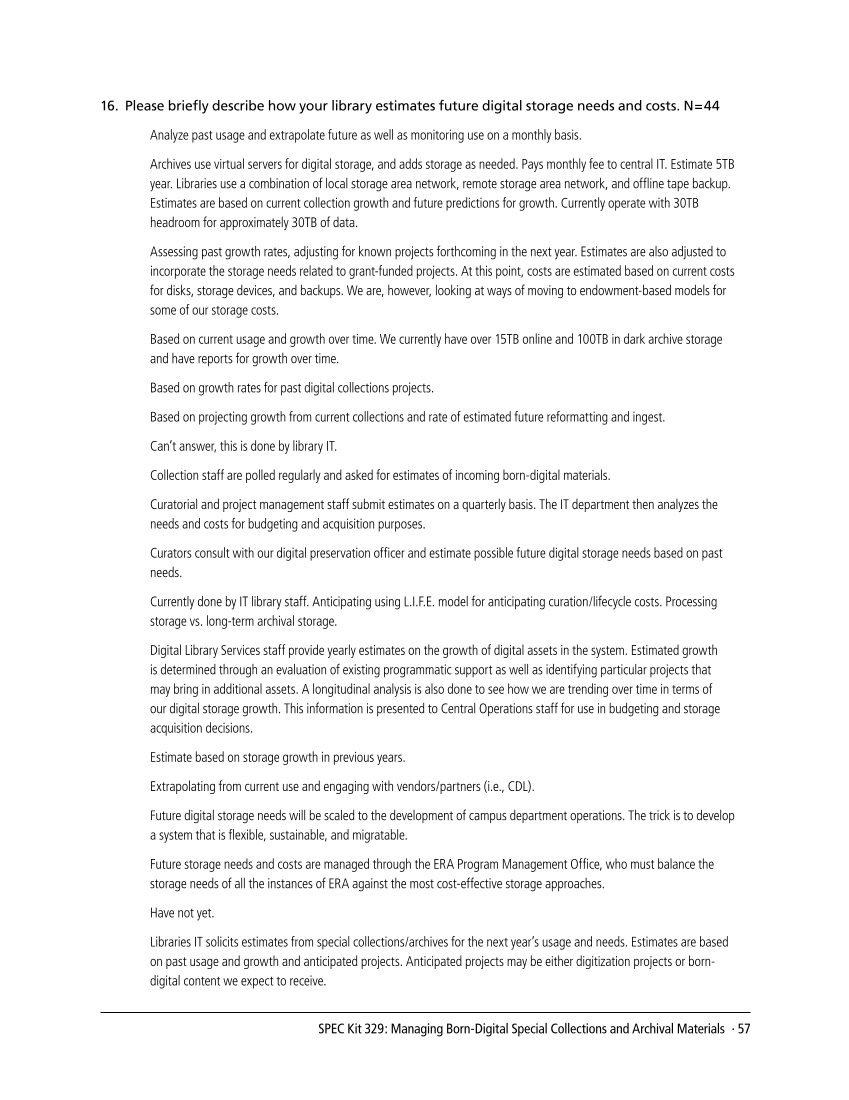SPEC Kit 329: Managing Born-Digital Special Collections and Archival Materials · 57
16. Please briefly describe how your library estimates future digital storage needs and costs. N=44
Analyze past usage and extrapolate future as well as monitoring use on a monthly basis.
Archives use virtual servers for digital storage, and adds storage as needed. Pays monthly fee to central IT. Estimate 5TB
year. Libraries use a combination of local storage area network, remote storage area network, and offline tape backup.
Estimates are based on current collection growth and future predictions for growth. Currently operate with 30TB
headroom for approximately 30TB of data.
Assessing past growth rates, adjusting for known projects forthcoming in the next year. Estimates are also adjusted to
incorporate the storage needs related to grant-funded projects. At this point, costs are estimated based on current costs
for disks, storage devices, and backups. We are, however, looking at ways of moving to endowment-based models for
some of our storage costs.
Based on current usage and growth over time. We currently have over 15TB online and 100TB in dark archive storage
and have reports for growth over time.
Based on growth rates for past digital collections projects.
Based on projecting growth from current collections and rate of estimated future reformatting and ingest.
Can’t answer, this is done by library IT.
Collection staff are polled regularly and asked for estimates of incoming born-digital materials.
Curatorial and project management staff submit estimates on a quarterly basis. The IT department then analyzes the
needs and costs for budgeting and acquisition purposes.
Curators consult with our digital preservation officer and estimate possible future digital storage needs based on past
needs.
Currently done by IT library staff. Anticipating using L.I.F.E. model for anticipating curation/lifecycle costs. Processing
storage vs. long-term archival storage.
Digital Library Services staff provide yearly estimates on the growth of digital assets in the system. Estimated growth
is determined through an evaluation of existing programmatic support as well as identifying particular projects that
may bring in additional assets. A longitudinal analysis is also done to see how we are trending over time in terms of
our digital storage growth. This information is presented to Central Operations staff for use in budgeting and storage
acquisition decisions.
Estimate based on storage growth in previous years.
Extrapolating from current use and engaging with vendors/partners (i.e., CDL).
Future digital storage needs will be scaled to the development of campus department operations. The trick is to develop
a system that is flexible, sustainable, and migratable.
Future storage needs and costs are managed through the ERA Program Management Office, who must balance the
storage needs of all the instances of ERA against the most cost-effective storage approaches.
Have not yet.
Libraries IT solicits estimates from special collections/archives for the next year’s usage and needs. Estimates are based
on past usage and growth and anticipated projects. Anticipated projects may be either digitization projects or born-
digital content we expect to receive.
16. Please briefly describe how your library estimates future digital storage needs and costs. N=44
Analyze past usage and extrapolate future as well as monitoring use on a monthly basis.
Archives use virtual servers for digital storage, and adds storage as needed. Pays monthly fee to central IT. Estimate 5TB
year. Libraries use a combination of local storage area network, remote storage area network, and offline tape backup.
Estimates are based on current collection growth and future predictions for growth. Currently operate with 30TB
headroom for approximately 30TB of data.
Assessing past growth rates, adjusting for known projects forthcoming in the next year. Estimates are also adjusted to
incorporate the storage needs related to grant-funded projects. At this point, costs are estimated based on current costs
for disks, storage devices, and backups. We are, however, looking at ways of moving to endowment-based models for
some of our storage costs.
Based on current usage and growth over time. We currently have over 15TB online and 100TB in dark archive storage
and have reports for growth over time.
Based on growth rates for past digital collections projects.
Based on projecting growth from current collections and rate of estimated future reformatting and ingest.
Can’t answer, this is done by library IT.
Collection staff are polled regularly and asked for estimates of incoming born-digital materials.
Curatorial and project management staff submit estimates on a quarterly basis. The IT department then analyzes the
needs and costs for budgeting and acquisition purposes.
Curators consult with our digital preservation officer and estimate possible future digital storage needs based on past
needs.
Currently done by IT library staff. Anticipating using L.I.F.E. model for anticipating curation/lifecycle costs. Processing
storage vs. long-term archival storage.
Digital Library Services staff provide yearly estimates on the growth of digital assets in the system. Estimated growth
is determined through an evaluation of existing programmatic support as well as identifying particular projects that
may bring in additional assets. A longitudinal analysis is also done to see how we are trending over time in terms of
our digital storage growth. This information is presented to Central Operations staff for use in budgeting and storage
acquisition decisions.
Estimate based on storage growth in previous years.
Extrapolating from current use and engaging with vendors/partners (i.e., CDL).
Future digital storage needs will be scaled to the development of campus department operations. The trick is to develop
a system that is flexible, sustainable, and migratable.
Future storage needs and costs are managed through the ERA Program Management Office, who must balance the
storage needs of all the instances of ERA against the most cost-effective storage approaches.
Have not yet.
Libraries IT solicits estimates from special collections/archives for the next year’s usage and needs. Estimates are based
on past usage and growth and anticipated projects. Anticipated projects may be either digitization projects or born-
digital content we expect to receive.










































































































































































































